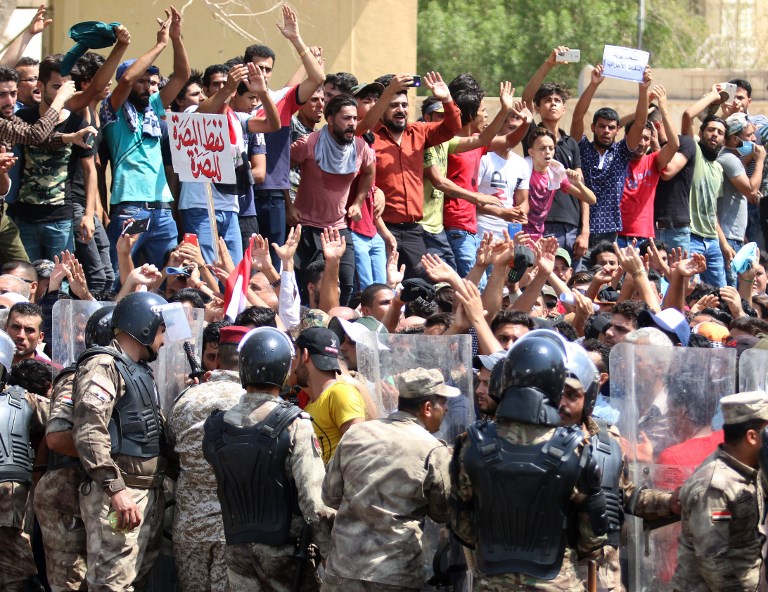As restive Iraqis rioted in the predominantly Shia south, politicians quarreled among themselves. Baghdad accused Iran of instigating the protests to twist arms and force the formation of a cabinet to its liking. Iran demurred. But if Baghdad politicians’ claims are even halfway true, it is curious that protesters have shown no favor toward Tehran, torching posters of Iranian ayatollahs and attacking offices of parties and militias close to the Islamic republic. While the fractious nature of Baghdad politics has hindered anything that approximates efficient governance, the riots demonstrate that it has also made it near impossible for Iran to dominate Iraq.
Indeed, anti-government rallies by Iraqi Shia tell an intriguing story of relations between them and Iran, the self-appointed leader of world Shia. Those relations, once assumed to be smooth, now look much more complicated than originally thought.
Back in 2003, in the early days of the US war in Iraq, many expected Iran either to annex the oil-rich south or to use the Shia majority to dominate Iraq. Neither happened, as Tehran struggled to get Iraqi Shia onside in a bid to replicate its successful experiment with the Shia of Lebanon. Iraq, it turns out, is no Lebanon.
The early days of Iraqi democracy saw the emergence of three monolithic blocs, the Shia, the Sunni and the Kurds. Each formed a ticket that contended for election in 2005. But by 2009, benefiting from windfall oil revenues that he used to grow his patronage network, former Prime Minister Nouri Al Maliki broke ranks with the “Shia House” that operated under Iranian supervision, and formed a ticket that beat Iran’s Shia in Iraq, and again in 2014.
Iran then threw its weight behind Al Maliki’s rivals, and managed to replace him with Haider Al Abadi. Unfortunately for Iran, Al Abadi followed in Al Maliki’s footsteps and used state resources to build his own network. This year in May, several independent Shia blocs contested for seats in parliament. Five Shia blocs were elected, and have been jockeying to form a cabinet since. With these many Shia heavyweights in parliament, along with their respective networks and militias, Iran has found it impossible to build Shia consensus behind Tehran’s leadership. On several occasions, Iran was forced to pick a favorite; and whenever it did, the remaining leaders ganged up on Tehran’s man and knocked him out.
Meanwhile, as Shia politicians bicker in Baghdad, ordinary Shia in the south have had to contend with corruption, high unemployment and broken-down infrastructure. Iraqi Shia have a more prosaic agenda: They want a better life. The “war on the ISIS terrorist” and other rallying cries in Lebanon that have bound the Shia there to Iran, find no traction with Iraqi Shia.
There are other complications for Iran in Iraq. According to the US treasury department, Iran funds Hezbollah to the tune of $700 million a year. To attempt to do the same in Iraq would be beyond Iran’s means.
Lebanon, like many countries in the Middle East, has not conducted a census since long ago – an honest account of the demographics would upend Lebanon’s existing confessional system that allocate power among the various religious and ethnic groups. Nevertheless, a proxy, in the form of voter lists, puts the number of Shia at 1.2 million. Like Lebanon, a census also is taboo in Iraq – a true accounting of the population would wreck the operating myths that fuel Iraqi politics. However, 24 million Iraqis registered to vote at the recent elections. Using this as proxy, a highly conservative estimate at best would put the number of Iraqi Shia at 12 million. If Iran were to fund Iraqi Shia at the same rate that it funds Lebanon’s Hezbollah, Tehran would need to cough up $7 billion each year, a sum that would blow a massive hole in its budget, where annual expenditures currently are at a little below $70 billion.
The second problem Iran faces in Iraq is a plurality of Shia religious leaders to rival Iranian clerics and the Iranian supreme leader, Ali Khamenei. Najaf, Kufa and Karbala are the historic cities where Shiism was born. They host the shrines of Shiism’s two most important imams, the first, Ali, and the third, his son Hussein. Najaf is to Shiism what Rome is to Catholicism. When Jawad Zarif was first appointed Iranian foreign minister in 2013, he made his first foreign trip to Najaf, where he met Grand Ayatollah Ali Sistani. After the meeting, the newspaper Kayhan – Khamenei’s mouthpiece – reported that Sistani had pledged allegiance to the leader of the Shia nation, Khamenei himself. Sistani’s office quickly rebutted this, denying the claims made in Kayhan. Iraq’s Shia clerics do not pay obeisance to Iran.
A third problem for Iran is Baghdad’s oil revenue, which is on par with or even higher than that of Iran. Such a stream of funds has given successive Iraqi leaders the resources to create their own patronage networks to rival any that Iran has fielded. And to Iran’s misfortune, every time Tehran pushed one of its own to become prime minister, he eventually turned his back on the Islamic republic and – tempted by the huge resources of the Iraqi state – started acting independently.
Iraq, thus, has proven a trying challenge to Iran’s ambitions of hegemony. While Iran, and the rest of the world, had expected Tehran to dominate Iraqi Shia, the latter has shown that that old adage is as true in Basra as anywhere else: all politics is local.
Hussain Abdul-Hussain is the Washington bureau chief of Kuwaiti daily Al-Rai and a former visiting fellow at Chatham House in London.
AFP PHOTO/HAIDER MOHAMMED ALI

